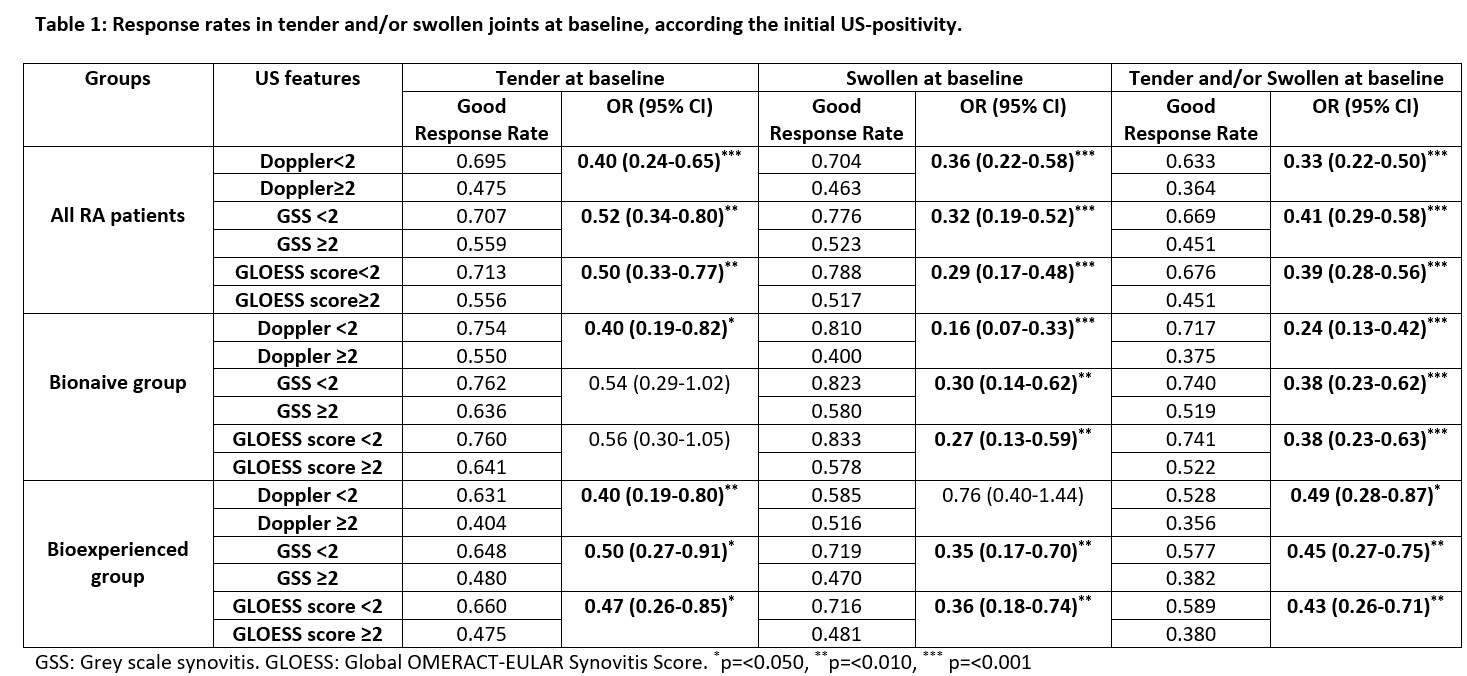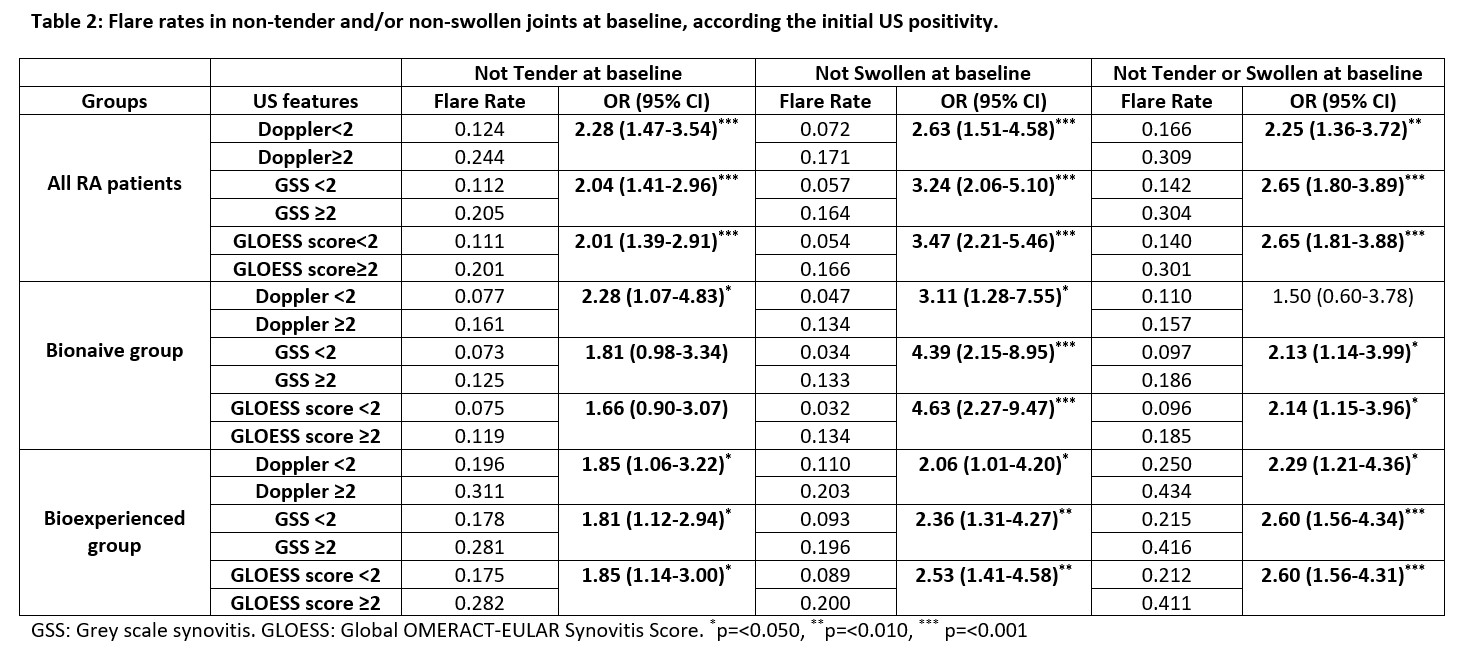Session Information
Date: Saturday, November 16, 2024
Title: Imaging of Rheumatic Diseases Poster I: Inflammatory Arthritis
Session Type: Poster Session A
Session Time: 10:30AM-12:30PM
Background/Purpose: There are discrepancies between physical examination and Ultrasound (US) in detecting inflammation in Rheumatoid Arthritis (RA). In this study, we aimed to understand, according to the presence of US findings at therapy initiation, a) for joints that are tender and/or swollen at baseline, what is the response rate (same joint being non-tender and/or non-swollen at follow up), b) for joints that are not tender and/or swollen at baseline, what is the risk of flare (being tender and/or swollen) at follow up; c) whether being bionaive or bioexperienced affects the relationship between US and physical examination.
Methods: At the ORCHESTRA (Ottawa Rheumatology CompreHEnSive TReatment and Assessment) Clinic RA patients starting a new advanced bDMARD/tsDMARD therapy are assessed using a comprehensive screening process which includes a protocoled US scan. Patients are evaluated in the same clinic three months after new therapy initiation. For this analysis, we included all MCP, PIP and wrist joints and analysis was performed on a joint level. Physical examination findings of the joint as baseline and at follow up were grouped according to having Global OMERACT-EULAR Synovitis Score (GLOESS),Doppler signals and gray scale score at baseline; grade ≥2 being considered as positive US for both features. Odds ratio (confidence intervals) were calculated a) for joints that were tender and/or swollen at baseline to understand the prediction of response; b) for joints that were not tender and/or not swollen at baseline to understand the prediction on flare.
Results: Sixty-seven RA patients (71.6% female) were included, with 1340 joints being analyzed. The median (IQR) tender and swollen joint counts were 9 (12) and 7 (6), respectively, with a DAS28 score of 3.72 (1.71). Thirty-eight patients (56.7%) were bio-naive at baseline.
Response: At baseline, 378 joints were tender, 320 joints were swollen, and 538 joints were tender and/or swollen. In all three groups, the response rate of patients with grade ≥2 Doppler, GS or GLOESS scores were lower than those without. In patients with positive US findings at baseline, the odds of achieving response were higher in tender joints than swollen joints (table-1).
Flare: At baseline, 962 joints were non-tender, 1020 joints were non-swollen, and 802 joints were non-tender and non-swollen. In all three groups, the flare rate of patients with grade ≥2 Doppler, GS or GLOESS scores was higher. In patients with positive US findings, the odds of developing a swollen joint were higher than the likelihood of developing a tender joint. In those with US findings at baseline, developing a swollen joint was more frequent in bio-naive patients than the bio-experienced (table-2).
Conclusion: Our study shows that the positive US findings at the initiation of an advanced therapy have two important meanings on a joint level: a) US – positive tender and/or swollen joints are more resistant to therapies (than US-negatives) and b) US- positive non-tender and/or non-swollen joints have a higher risk of becoming symptomatic. It is still not clear how the US should be incorporated into the treatment algorithms, but the US information suggests a different patient phenotype.
To cite this abstract in AMA style:
Sabido-Sauri R, Acikgoz S, Gazel U, Bayindir Tsechelidis O, Sangwa S, Ivory C, Hepworth E, Aydin S. The Prediction of Response to Advanced Therapies on a Joint Level in Rheumatoid Arthritis: The Interpretation of Tenderness and Doppler Ultrasound [abstract]. Arthritis Rheumatol. 2024; 76 (suppl 9). https://acrabstracts.org/abstract/the-prediction-of-response-to-advanced-therapies-on-a-joint-level-in-rheumatoid-arthritis-the-interpretation-of-tenderness-and-doppler-ultrasound-2/. Accessed .« Back to ACR Convergence 2024
ACR Meeting Abstracts - https://acrabstracts.org/abstract/the-prediction-of-response-to-advanced-therapies-on-a-joint-level-in-rheumatoid-arthritis-the-interpretation-of-tenderness-and-doppler-ultrasound-2/


